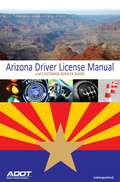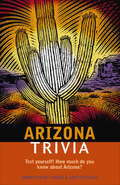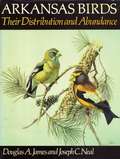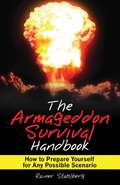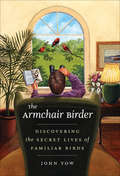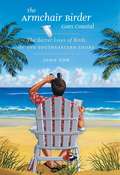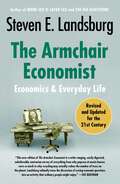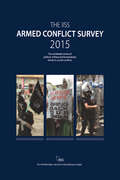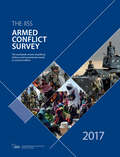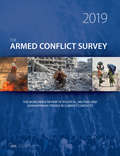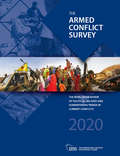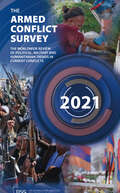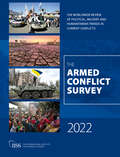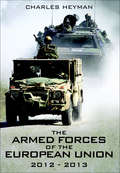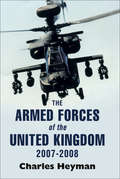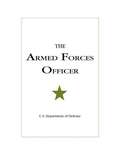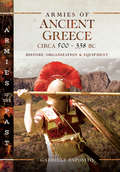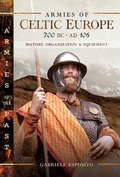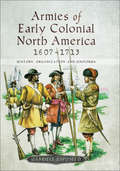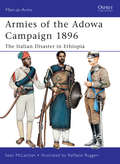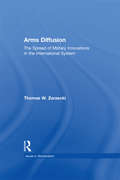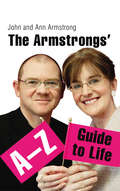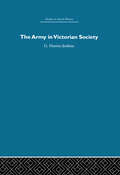- Table View
- List View
Arizona Driver License Manual
by Arizona Department of TransportationThe Arizona Department of Transportation Motor Vehicle Division (ADOT MVD) is pleased to provide this guide to Arizona traffic laws and information for obtaining a driver license or identification card. This manual also provides essential safety information for both new and experienced Arizona drivers.
Arizona Trivia
by James CrutchfieldArizona was the last continental state to enter the Union. Arizona Trivia is full of fun facts about this young state. Approximately how many rounds of golf were played in Phoenix in 2000? And what are the deepest and widest points of the Grand Canyon? (Answers: 11 million; 6,000 vertical feet, and 18 miles wide.) This book is the who, what, when, where, why, and how of the Grand Canyon State.
Arkansas Birds: Their Distribution and Abundance
by Douglas A. James Joseph C. NealThis edition has an in-depth reference work on Arkansas birds. It includes interesting quotations from 19th -century ornithologists and nature historians as well as evidence from more recent research.
The Armageddon Survival Handbook: How to Prepare Yourself for Any Possible Scenario
by Rainer StahlbergGrowing up in Soviet-dominated Hungary, Rainer Stahlberg developed an increasing wariness of the world around him. When he was wounded in the Hungarian uprising of 1956, he resolved to never be caught unprepared again. Let him prepare you for any crisis. Here he details a step-by-step plan for surviving a vast range of disasters--both natural and manmade. From storms and floods to economic strife, nuclear warfare, and international terrorism, this is the ultimate handbook of disaster scenarios and survival techniques. Be ready for an energy crisis, global economic collapse, climate change, and a multitude of other terrifying-to-think-about scenarios. This book could save your life!
The Armchair Birder: Discovering the Secret Lives of Familiar Birds
by John YowBird lovers, take heart! While the birding literature is filled with tales of expert observers spotting rare species in exotic locales, John Yow's The Armchair Birder reminds us that the most fascinating birds can be the ones perched right outside our windows. In thirty-five engaging, humorous, and even irreverent essays, Yow reveals the fascinating lives of birds you probably already recognize and naturally want to know more about--because they're the ones you see nearly every day. Following the seasons of the year, Yow covers forty-two species, from the Carolina wren that rings in the springtime to the sandhill crane croaking high overhead at the end of winter. Leisurely and entertaining, the essays explore the improbable, unusual, and comical aspects of their subjects' lives--from the philandering of the ruby-throated hummingbird to the occasional dipsomania of the cedar waxwing. Rather than bare facts and field marks, The Armchair Birder offers observations, anecdotes, and stories--not only Yow's own, but also those of America's classic bird writers, such as John James Audubon, Arthur Bent, and Edward Forbush, experts who saw it all and wrote with wit and passion. With The Armchair Birder, backyard birders will take new delight in the birds at their feeders, while veteran check-listers will enjoy putting their feet up. All will applaud this unique addition to bird literature, one that combines the fascination of bird life with the pleasure of good reading.
The Armchair Birder Goes Coastal
by John YowWith his distinctively witty, anecdotal, and disarming voice, John Yow now journeys to the shore and shares his encounters with some of the most familiar and beloved coastal birds. Out of his travels--from North Carolina's Outer Banks, down the Atlantic coast, and westward along the Gulf of Mexico--come colorful accounts of twenty-eight species, from ubiquitous beach birds like sanderlings and laughing gulls to wonders of nature like roseate spoonbills and the American avocets. Along the way, Yow delves deeply into the birds' habits and behaviors, experiencing and relating the fascination that leads many an amateur naturalist to become the most unusual of species--a birder.Seasonally organized chapters explore the improbable, the wonderful, and the amusing aspects of these birds' lives. Yow embellishes his observations with field notes, anecdotes, and stories from some of America's finest naturalists--including John James Audubon, Arthur Cleveland Bent, Rachel Carson, and Peter Matthiessen. Combining the endless fascination of bird life with the pleasure of good reading, The Armchair Birder Goes Coastal is the perfect companion for any nature lover's next trip to the beach.
The Armchair Birder's Omnibus Ebook
by John YowAvailable for the first time together in this Omnibus E-Book, The Armchair Birder's Omnibus brings together both of John Yow's delightful books into one convenient e-book.While birding literature is filled with tales of expert observers spotting rare species in exotic locales, John Yow reminds us in The Armchair Birder, that the most fascinating birds can be the ones perched right outside our windows. In thirty-five engaging and sometimes irreverent vignettes, Yow reveals the fascinating lives of the birds we see nearly every day. Following the seasons, he covers forty-two species, discussing the improbable, unusual, and comical aspects of his subjects' lives. Yow offers his own observations, anecdotes, and stories as well as those of America's classic bird writers, such as John James Audubon, Arthur Bent, and Edward Forbush. This unique addition to bird literature combines the fascination of bird life with the pleasure of good reading.In his follow-up volume The Armchair Birder Goes Coastal, Yow now journeys to the shore and shares his encounters with some of the most familiar and beloved coastal birds. Out of his travels--from North Carolina's Outer Banks, down the Atlantic coast, and westward along the Gulf of Mexico--come colorful accounts of twenty-eight species, from ubiquitous beach birds like sanderlings and laughing gulls to wonders of nature like roseate spoonbills and the American avocets. Along the way, Yow delves deeply into the birds' habits and behaviors, experiencing and relating the fascination that leads many an amateur naturalist to become the most unusual of species--a birder.
The Armchair Economist: Economics & Everyday Life (revised and updated May #2012)
by Steven E. LandsburgThe extensively revised and updated edition of Steven Landsburg’s hugely popular book, The Armchair Economist—“a delightful compendium of quotidian examples illustrating important economic and financial theories” (The Journal of Finance).In this revised and updated edition of Steven Landsburg’s hugely popular book, he applies economic theory to today’s most pressing concerns, answering a diverse range of daring questions, such as:Why are seat belts deadly? Why do celebrity endorsements sell products? Why are failed executives paid so much? Who should bear the cost of oil spills? Do government deficits matter? How is workplace safety bad for workers? What’s wrong with the local foods movement? Which rich people can’t be taxed? Why is rising unemployment sometimes good? Why do women pay more at the dry cleaner? Why is life full of disappointments?Whether these are nagging questions you’ve always had, or ones you never even thought to ask, this new edition of The Armchair Economist turns the eternal ideas of economic theory into concrete answers that you can use to navigate the challenges of contemporary life.
Armed Conflict Survey (Armed Conflict Survey Ser.)
by Nigel InksterThis book provides data on fatalities, refugees and separated people for all major armed conflicts in the Middle East, Sub-Saharan Africa, South Asia, Asia-Pacific, Europe and Eurasia, and Latin America in 2015, alongside in-depth analysis of their political, military and humanitarian dimensions.
Armed Conflict Survey 2017 (Armed Conflict Survey Ser.)
by The International Institute for Strategic StudiesThe Armed Conflict Survey provides in-depth analysis of the political, military and humanitarian dimensions of all major armed conflicts, as well as data on fatalities, refugees and internally displaced persons. Compiled by the IISS, publisher of The Military Balance, it is the standard reference work on contemporary conflict. The book assesses key developments in 36 conflicts, including those in Iraq, Syria, Afghanistan, South Sudan, Israel–Palestine, Southern Thailand, Colombia and Ukraine.The Armed Conflict Survey also features chapters on UN peacekeeping; sexual violence; the Islamic State’s shifting narrative; governance by armed groups and rebel-to-party transitions.
Armed Conflict Survey 2019
by The International Institute for Strategic StudiesThe Armed Conflict Survey provides in-depth analysis of the political, military and humanitarian dimensions of all major armed conflicts, as well as data on fatalities, refugees and internally displaced persons. Compiled by the IISS, publisher of The Military Balance, it is the standard reference work on contemporary conflict. The book assesses key developments in 36 high-, medium- and low-intensity conflicts, including those in Iraq, Syria, Afghanistan, South Sudan, Israel–Palestine, Southern Thailand, Colombia and Ukraine. The Armed Conflict Survey features essays by some of the world’s leading experts on armed conflict, including Mats Berdal, Elisabeth Jean Wood, Julia Bleckner, Nelly Lahoud, William Reno and Carrie Manning. They write on: • UN peacekeeping; • conflict-related sexual violence; • the Islamic State’s shifting narrative; • the changing foundations of governance by armed groups; and • rebel-to-party transitions. The authors’ discussion of principal thematic and cross-national trends complements the detailed analysis of each conflict at the core of the book. The Armed Conflict Survey also includes maps, infographics and multi-year data, as well as the IISS Chart of Conflict.
Armed Conflict Survey 2020
by The International Institute for Strategic StudiesThe Armed Conflict Survey is the annual review of the political, military and humanitarian dimensions of all active conflicts from the International Institute for Strategic Studies. It offers in-depth analysis of the drivers, dynamics and impact of 33 current wars along with detailed information on conflict parties and more than 60 full-colour maps and infographics. The Armed Conflict Survey is an essential resource for those involved in security policymaking, and an indispensable handbook for anyone conducting serious analysis of armed conflict. Key features · Essays on global trends in armed conflict with a focus on armed groups and their increasingly horizontal structures, adaptability and propensity for exploiting technology. · Overviews of key events and political and military developments in 2019 for each conflict. · In-depth analysis of the underlying drivers and historical roots of conflicts. · Expanded information on conflict parties. · New timelines showing the key political and military developments of 2019. · Analysis of the humanitarian, social and economic impact of conflicts. · Conflict-specific trends, strategic implications and prospects for peace. · More than 60 full-colour maps, tables and infographics highlighting key conflict developments and data. · Key statistics on refugees, internally displaced persons and people in need. · The 2020 Chart of Armed Conflict, providing an overview of conflict actors including state forces, armed groups and multinational missions to conflict and post-conflict countries.
Armed Conflict Survey 2021
by The International Institute for Strategic StudiesThe Armed Conflict Survey is the annual review of the political, military and humanitarian dimensions of all active conflicts from the International Institute for Strategic Studies. It offers in-depth analysis of the drivers, dynamics and outlook of 34 current armed conflicts along with detailed information on conflict parties and more than 60 full-colour maps and infographics. The Armed Conflict Survey is an essential resource for those involved in security, foreign and humanitarian policymaking, and an indispensable handbook for anyone conducting serious analysis of armed conflict. Key features · Essays on global trends in armed conflict, with a focus on the changing nature of third-party intervention, the long aftermath of armed conflicts, and economic migration and forced displacement in a COVID-19 world. · Overviews of key events and political and military developments from January 2020–February 2021 for each conflict. · Strategic analysis of national and regional drivers and conflict outlooks. · Regional analyses with unique insights into the geopolitical and geo-economic threads linking conflicts across regions and globally. · Expanded information on conflict parties. · The Armed Conflict Global Relevance Indicator (ACGRI), an IISS proprietary indicator that combines measures of incidence and human impact with geopolitical impact to assess the global salience of armed conflicts. · Analysis of the humanitarian, social and economic impact of conflicts. · Conflict-specific trends, strategic implications and prospects for peace. · More than 60 full-colour maps, tables and infographics highlighting key conflict developments and data. · Key statistics on violent events, fatalities, military power, geopolitical salience, refugees and internally displaced persons. · The 2021 Chart of Armed Conflict, presenting information on conflict start dates, typologies and relevant refugee flows, as well as providing a visual overview of each conflict’s geopolitical relevance, looking at 2020 UN Security Council resolutions, multilateral missions and the involvement of third-party countries.
Armed Conflict Survey 2022
by The International Institute for Strategic StudiesThe Armed Conflict Survey 2022 provides an exhaustive review of the political, military and humanitarian dimensions of 33 active armed conflicts globally in the period from 1 March 2021 to 30 April 2022. The review is complemented by a strategic analysis of national, regional and global drivers and conflict outlooks, providing unique insights into the geopolitical and geo-economic threads linking conflicts across the world, as well as into emerging flashpoints and political risks. This edition includes a special feature on climate security given the increasingly urgent need to understand the complex interlinkages between climate change, climate vulnerability and conflict amid accelerating global warming. Reflecting the growing importance of geopolitical factors in the current global conflict landscape, The Armed Conflict Survey 2022 features the IISS Armed Conflict Global Relevance Indicator, which compares the global relevance of armed conflicts in terms of their geopolitical impact, as well as their human impact and intensity. This edition also includes maps, infographics and key statistics, as well as the accompanying Chart of Armed Conflict.
The Armed Forces of the European Union, 2012–2013
by Charles HeymanThis first edition of an entirely new publication will, for the first time, provide comprehensive information on what is one of the worlds largest military force groupings. The European Unions 25 member states have defense forces that include over 1.6 million personnel and inventories that include over 35,000 armored vehicles, 2,000 combat aircraft, 60 submarines and over 140 major surface vessels.Chapters will include important facts and figures related to European defense, detail concerning the European Union Military Committee and the European Defense Agency. Also included will be information about European Union military roles, the Eurocorps and European Union Battlegroups. In addition, there will be detail regarding the force structure of the 25 member states and characteristics of the major land, sea and air equipment.
The Armed Forces of the United Kingdom, 2007–2008
by Charles HeymanThis comprehensive pocket guide includes full and up-to-date details of all British military organizations and structures. This edition includes detail regarding all of the UK MoDs latest future force proposals.The Armed Forces of the United Kindom 2007–2008 is an invaluable reference tool and essential reading for all those who wish to be informed of the current state of the UKs defence forces.
The Armed Forces Officer
by U.S. Department of DefenseThis edition is a classic series of books of the same title. These books have provided a foundation of thought, conduct, standards, and duty for American commissioned officers. Available now to the general public, this new edition takes the series inspirational premise into the new century. It educates officers of all services, as well as civilians, about the fundamental moral-ethical requirements of being a commissioned officer in the armed forces of the United States.
Armies of Ancient Greece Circa 500–338 BC: History, Organization & Equipment (Armies Of The Past Ser.)
by Gabriele EspositoIllustrated with color photos, this guide details the arms, armor, organization, and tactics of Classical Greek armies.The Classical period includes some of the most famous wars and battles of Ancient Greece, including the defeat of the Persians at Marathon, the Spartans’ last stand at Thermopylae, the Peloponnesian War and the March of the Ten Thousand. The Greek heavy infantry spearmen, or hoplites, are one of the most recognizable types of ancient warrior and their tightly-packed phalanx formation dominated the battlefield.Covering the period from the Persian Wars to the Macedonian victory at the Battle of Chaeronea, Gabriele Esposito examines the famous hoplites heavy infantry as well as other troops, such as light infantry skirmishers and cavalry. His clear, informative text is beautifully illustrated with dozens of color photographs showing how the equipment was worn and used.
Armies of Celtic Europe, 700 BC–AD 106: History, Organization & Equipment (Armies of the Past)
by Gabriele EspositoA look at the military might of these ancient warriors who sacked Rome and conquered much of Europe. Although comprised of many distinct tribes and groupings, the Celts shared a distinctive culture that dominated much of Europe for centuries, and enjoyed a formidable reputation as fierce and brave warriors, skilled horsemen, and fine metalworkers. In 390 BC, an alliance of Celtic tribes defeated a Roman army at the River Allia and went on to sack Rome and thenceforth the Romans lived under their threat. In the early third century BC, a Celtic army swept into Macedonia and Greece, won a major victory at Thermopylai, and ransacked the sacred sanctuary at Delphi. Such was their warlike prowess that, when not fighting their own wars, they were sought after as mercenaries by many armies, serving as far afield as southern Egypt. When the Romans invaded Gaul—modern-day France and Belgium—and the British Isles, Celtic armies resisted them fiercely. In this book, Gabriele Esposito studies this fascinating warrior culture, their armies, strategy, tactics, and equipment—they invented the horned saddle and chainmail, and British armies were the last in Europe to use chariots on the battlefield. Also included are dozens of color photographs of reenactors to help bring these magnificent warriors back to life.
Armies of Celtic Europe, 700 BC–AD 106: History, Organization & Equipment (Armies of the Past)
by Gabriele EspositoA look at the military might of these ancient warriors who sacked Rome and conquered much of Europe. Although comprised of many distinct tribes and groupings, the Celts shared a distinctive culture that dominated much of Europe for centuries, and enjoyed a formidable reputation as fierce and brave warriors, skilled horsemen, and fine metalworkers. In 390 BC, an alliance of Celtic tribes defeated a Roman army at the River Allia and went on to sack Rome and thenceforth the Romans lived under their threat. In the early third century BC, a Celtic army swept into Macedonia and Greece, won a major victory at Thermopylai, and ransacked the sacred sanctuary at Delphi. Such was their warlike prowess that, when not fighting their own wars, they were sought after as mercenaries by many armies, serving as far afield as southern Egypt. When the Romans invaded Gaul—modern-day France and Belgium—and the British Isles, Celtic armies resisted them fiercely. In this book, Gabriele Esposito studies this fascinating warrior culture, their armies, strategy, tactics, and equipment—they invented the horned saddle and chainmail, and British armies were the last in Europe to use chariots on the battlefield. Also included are dozens of color photographs of reenactors to help bring these magnificent warriors back to life.
Armies of Early Colonial North America, 1607–1713: History, Organization and Uniforms
by Gabriele EspositoGabriele Esposito presents a detailed overview of the military history of Colonial North America during its earliest period, from the first colonial settlement in Jamestown to the end of the first continental war fought in the Americas. He follows the development of organization and uniforms not only for the British Colonies of North America but also for the French ones of Canada. Every colonial unit formed by the Europeans in the New World, as well as the regular troops sent to America by Britain and France, is covered in detail: from the early militias of the Thirteen Colonies to the expeditionary forces formed during the War of the Spanish Succession. Great military events, like King Philips War or Bacons Rebellion, are analyzed and the evolution of tactics employed in this theater are discussed, showing how much warfare was influenced by the terrain and conditions in North America. Dozens of illustrations, including color art works, show the first military uniforms ever worn in North America, as well as interesting details of weaponry and equipment used.
Armies of the Adowa Campaign 1896
by Sean Mclachlan Raffaele RuggeriIn the late 19th century, the new nation-state of Italy was eager to join her European neighbors in creating an international empire. Italy's eyes turned towards Africa as a source of potential colonies. Most of the continent had already been carved up between the Great Powers but Italy succeeded in securing a foothold in Eritrea on the Red Sea coast, a vassal of the Emperor of Ethiopia. Trade and other links were established with the Ethiopian empire but quarrels regarding the interpretation of a particular clause led to Ethiopian support for uprisings in Eritrea. Italian troops entered northern Ethiopia and captured Adowa, the capital of the Tigray province. Full-scale war broke out and this new Osprey title tracks every development in the battle and the men who fought in it.From the Trade Paperback edition.
Arms Diffusion: The Spread of Military Innovations in the International System (Issues in Globalization)
by THomas W. ZarzeckiWeapons proliferation is one of the most pressing global concerns following the end of the Cold War. Despite the absence of an overarching superpower conflict, armaments and related technologies have continued to spread throughout the international system. This has been particularly true in areas like East Asia and the Middle East, where the traditional two party arms races are not readily apparent. This text addresses these concerns and shortcomings using data on fourteen specific military technological innovations that diffused throughout the international system from 1960 to 1997.
The Armstrongs' A-Z Guide to Life
by Ann Armstrong John ArmstrongHave you ever wondered how typewriters can rival commercial radio? Why, according to John, it's best to shave only once a week, and with old fashioned soap and water? And what the various repercussions of spring and its extra hour of daylight bring?The BBC created a fantastically cult television series when they filmed the daily operations of John and Ann's double glazing firm U-Fit, the third largest in Coventry. It was here we were first introduced to John's misanthropic musings and no-nonsense attitude to management and his wife Ann's doting loyalty. Now their individual and highly entertaining personalities have been brought to the page, as they ruminate on various aspects of life from asbos to Buddhism, and Chekov to Maltesers.
The Army in Victorian Society
by G. Harries-JenkinsAlthough in Victorian society the Army was the aristocratic backbone of England, it was persistently engaged in fighting Colonial Wars.
